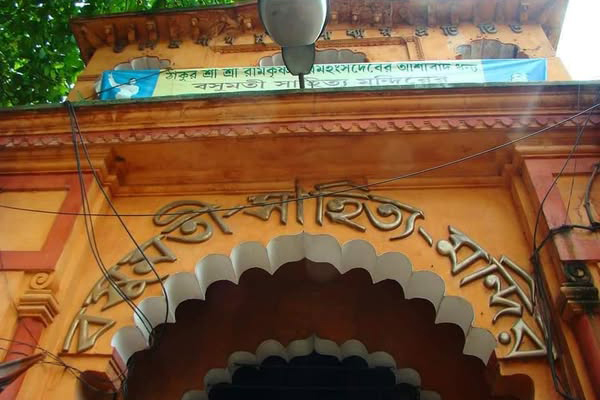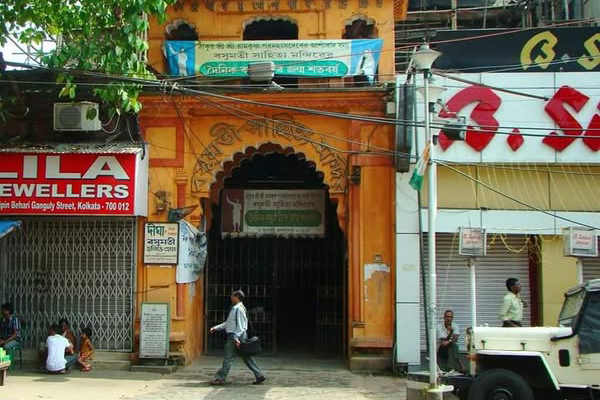Basumati Sahitya Mandir Bhavan
Anindita Mazumder
Basumati Sahitya Mandir Bhawan is a two-century-old house on 166 Bipin Behari Ganguly Street that originally belonged to Dutch settlers who had settled in and around the Bowbazar area which had significant Christian population. The huge windows and doors along with its high ceiling bear testimony of its Dutch legacy. There was a large pond in front, a source of drinking water for neighbouring households, at a time when piped water was yet to be a reality. On the back there was a small plot, overlooked by a banyan tree. Beyond it, one could see the stones on the graves of the Dutch settlers. Both the pond and the graves have been lost in the abyss of time.
After the Dutch owners had departed, the house remained vacant for some time. In 1854 the first art school of India was started. Calcutta Industrial Art School was set up to provide instruction in modelling, engraving and printing at Garanhata, Chitpur. In 1864, the school came under the Government of Bengal and shifted to these premises. In 1874 – 75, an art gallery was set up in two adjoining halls on the first floor to display the art work of the students. Light streaming through the large skylights made it a perfect venue for display. Although the art college later shifted to Dharamtala as the number of students increased, the art gallery continued in the premises till 1894.

Then it was the turn of the prestigious Bengal National College to shift here. The college was set up as a part of the Swadeshi Movement that swept Bengal following its Partition. In June 1907, the Bengal National College was shifted to 164 & 166 Bowbazar Street. The building was taken on a lease of five years at a monthly rent of Rs 450. Its first principal Aurobindo Ghosh was a regular and many of the nationalist leaders visited the house. Every day, after classes got over, under the guidance of instructors from Bipin Behari Ganguly’s Atmaunnati Samity, the students practised wielding of sticks at the rear portion. After resigning as principal, Aurobindo, on August 23, 1907 delivered a parting address to his beloved students. “If you will study, study for Her sake; train yourselves body and mind and soul for Her service… Work that She may prosper. Suffer that She may rejoice,” he had said, a commemorative plaque reminds us of his soul stirring words.
Once the college shifted, the three Dutch owners became keen to sell off the property and through Krishnakumar Mitra, a nationalist leader it was bought by Upendranath Mukhopadhyay for his publication, Basumati. Mukhopadhyay was a close devotee of Ramakrishna Paramhansa.
Upendranath Mukhopadhyay started off at a book seller’s shop at Battala earning Rs 5 and went on to buy that shop, perhaps in 1880. Once, when Ramakrishna visited the small shop, Upendranath was embarrassed by the low height of the entrance and his guru consoled him saying one day the door would be bigger. When we now look at the large doors and windows at Basumati Sahitya Mandir Bhawan, we realise the truth of his words.
An old hand press was bought at Rs 14 by Swami Yogananda for Upendranath. Sahitya Kalpadrum was the first monthly magazine started by him and Narendranath started to translate Imitation of Christ for the magazine. Upendranath, a childhood friend of Swami Vivekananda, greatly benefited from the latter’s advice whenever doubts clouded his mind. Following Swamiji’s advice, he published Rajbhasha, a book for English language learners which became popular and earned him his fortune. Upendranath and his publication house played a significant role in Ramakrishna-Vivekananda movement. His love for literature led to publication of many books, many of them were translations of Sanskrit and English texts and played a great role in spreading literacy. Basumati Sahitya Mandir ensured the tomes of Bankimchandra, Mahabharat by Kaliprasanna Singha, works of Tekchand, Nabinchandra and Hemchandra and even Rabindranath were available to readers at a reasonable price.
Upendranath started publishing Basumati as a weekly paper in August 1896. Most of the contemporary publications were run by prominent Brahmos and Basumati’s importance can be assessed in this light. However, in its first edition, the proprietor outlined its varied interests – politics, grievances, history, urbanisation, farming, trade and commerce, glory of Hinduism, scriptures, humour and so on.

Ramakrishna’s disciple Latu Maharaj often resided at the Basumati press and Upendranath would give him money to buy food which he would share with the workers of the press. When Indian Nation attacked Swamiji post Chicago speech, Upendranath lodged a strong protest. Swamiji had given the namaskar mantra, Namo Narayanai (narayan refers to the inner god) to Saptahik Basumati which was printed along the mast head as a motto.
In the beginning of twentieth century, Basumati appeared as leading newspaper and earned great popularity. Within a week of the beginning of World War I on August 6, 1914, Dainik Basumati was launched. Monthly Basumati was launched after 8 years. An English edition was also launched for a short time. Meanwhile, in 1919 after Upendranath’s death his son Satishchandra Mukhopadhyay took over and continued the good work. Although Upendranath never stayed at this house Satishchandra occupied a portion of the house with his family. There had been gradual additions in the front and rear of the house and another floor was constructed above the two storey building. Durga Puja and Sarswati Puja were celebrated with great fanfare. Satishchandra had set up the Radhakrishna idol on the top floor and made the house a debottar property.
Hemendraprasad Ghosh was the first editor of Dainik Basumati. As a leading representative of Indian Press he visited Iraq in 1917 and also several war theatres of Europe. He had to undergo court arrest at least thrice in 1930s on charges of sedition for his writings. When the Bengal government cracked down on Dainik Basumati because of its uncompromising editorials, and stopped its publication in 1941, Basumati Telegram surfaced. Other noted editors included revolutionary Upendranath Bandhopadhyay, Barindrakumar Ghosh and Bibekananda Mukhopadhyay. This house was frequented by leaders and freedom fighters including Surendranath Bandhopadhyay, Chittaranjan Das, Bipinchandra Pal, Sarojini Naidu, Jatindramohan Sengupta, Saratchandra Bose and Subhaschandra Bose.
Basumati’s misfortunes in later years have been reflected in the sad state of the building. The frontage has a statue of Saraswati playing veena and under it the words in stucco reads in Bengali: “Basumati Sahitya Mandir, Established by Upendranath Mukhopadhyay in 1287”. Another important feature is the huge stained glass panel depicting motifs of lotuses, Swastika and the globe. Obscured by hoardings and signages, this heritage building seems to be a former shadow of itself.
